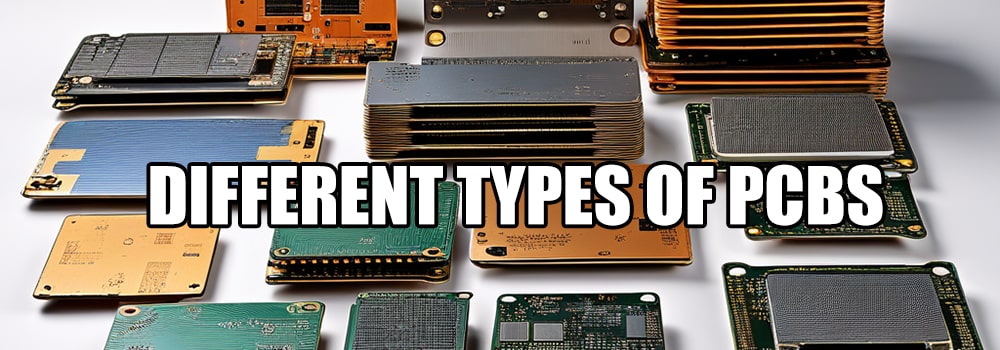What are the different types of PCB used for?
21 January 2025
Views: 1803
There are many different types of printed circuit boards, each with different characteristics. In this article, we will take a closer look at the main types of PCBs and the main areas of application.

Types of PCBs
PCBs can be categorized based on structure, material, hardness, and properties.
Based on the structure it can be categorized into single-sided, double-sided, and multilayer boards.
Single-sided PCB are the most basic and simple type of PCB, where the components are present on one side only. Single-sided PCBs are low-cost and simple to manufacture, and are commonly used in simple electronic devices such as consumer electronics, power supplies, and printers.
Double-sided PCB are PCBs with conductive layers on both sides and are the most common type of board. This type is suitable for electronic circuits of medium complexity and has applications in communications equipment, industrial controls, automotive instrument panels, and other areas.
Multilayer PCB is a PCB with more than two layers, up to 40 or more, each conductor layer is separated by insulating material, suitable for high-density circuit design. It is mainly used in high precision fields, such as medical meter, satellite system, military equipment and so on.
PCBs can be categorized according to their hardness into rigid, flexible, and rigid-flexible PCBs.
Rigid PCB are made of strong, unbendable materials such as fiberglass and epoxy. Rigid PCBs are cheaper and easier to manufacture and are the most popular and common board type. They are commonly used in computers, consumer electronics and industrial equipment.
Flexible PCB are made of flexible materials such as polyimide and can be bent and flexed. The flexible and bendable nature makes it suitable for devices that have less space and need to be folded and bent. Flexible circuit boards are needed for everyday use in smart phones, watches, medical devices, etc.
Rigid-flex PCB combine the advantages of both. Most of them are made up of multiple layers of rigid PCBs, and some of them are connected by flexible PCBs. The combination provides stability and flexibility and is often used in aerospace, military and medical equipment.
PCB can be classified according to material as aluminum, resin, PTFE, or ceramic PCBs.
Aluminum PCB are made from a metal core substrate with a thermally conductive dielectric layer and copper traces. Commonly used in high power and high current applications such as power supplies, LED lighting and motor controllers.
Resin PCB are made from resin-based materials and are known for their excellent moisture resistance, chemical resistance, and flame retardancy. Commonly used in automotive, industrial and consumer electronics.
PTFE PCB are made from PTFE-based materials and have good dielectric properties, low loss angular tangent and high frequency performance. Commonly used in applications such as RF and microwave circuits, high speed digital circuits and antennas.
Ceramic PCB are made from high purity alumina or aluminum nitride and are known for very good thermal conductivity, electrical insulation and mechanical strength. Typically used in high power and high frequency applications such as RF and microwave circuits, power modules and LED lighting.
According to the performance of the classification can be divided into HDI, high-voltage, RF, high-speed, high Tg, high-frequency PCB.
HDI PCB: High Density Interconnect PCB, line spacing 45um or less, suitable for high-density chip packaging, commonly used in small electronic devices, cell phones, smart watches and so on.
High-voltage PCB: using a thick insulating substrate, high voltage shock resistance, used for applications with voltages higher than 60V at both ends, commonly used in power supplies, transformers and so on.
RF PCB: Using excellent conductive and low loss materials such as copper or silver, suitable for UHF to SHF RF systems, commonly used in medical, military and other fields.
High Speed PCB: Low dielectric constant substrate and fine line, suitable for high speed digital and communication applications with operating frequency over 1GHz, commonly used in medical and robotics fields.
High Tg PCB: Using FR-4 substrates with high glass transition temperatures, these PCBs can withstand operating temperatures above 150°C and are commonly used in automotive and industrial applications.
High-frequency PCB: using low-loss materials such as PTFE, suitable for microwave and RF circuits with an operating frequency of more than 1GHz, commonly used in computer network systems.
The above list is not all the types of PCB, just the more common types of PCB, according to different application requirements to choose the right type of PCB can achieve better performance and functionality. In life we can be common PCB types are double-sided multilayer PCB, aluminum PCB, HDI PCB.
Share This Story, Choose Your Platform!
